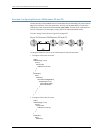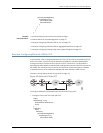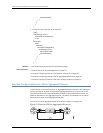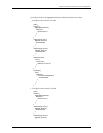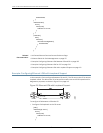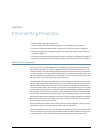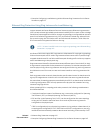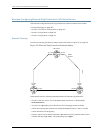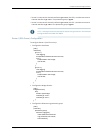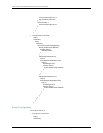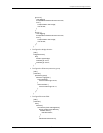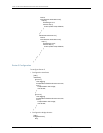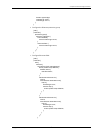
Every node on the ring is one of two types:
•
RPLownernode—Thisnode ownstheRPL andblocks orunblockstheRPL as conditions
require. This node initiates the R-APS message.
•
Normal node—All other nodes on the ring (that is, those that are not the RPL owner
node) operate as normal nodes and have no special role on the ring.
In addition to roles, each node on the Ethernet ring can be in one of several states:
•
Init—The node is not yet participating in the ring.
•
Idle—The node is performing normally (there is no link failure on the ring). In this state,
traffic is unblocked on both ring ports, except for the RPL owner node, which blocks
the RPL port (the other RPL owner port is unblocked).
•
Protection—When a failure occurs on the ring, a normal node will have traffic blocked
on the ring port that connects to the failed link. The RPL owner, if it is not at one end
of the failed link, will then unblock the RPL port so both ports are active.
NOTE: The R-APS protocol does not detect the number of RPL ownernodes
configured on the ring. You must configure only one RPL and RPL owner per
ring or protection switching will not work properly.
Ethernet ring protection only works when one link on the ring fails. Multiple link failures
will break the ring and cause protection switching to fail.
Several restrictions apply to Ethernet ring protection:
•
The Ethernet ring protection configured as a single instance only works at the physical
level (adjacent nodes must be directly connected). The ring protection operates at
the interface (port) level and not at the VLAN level.
•
Manual (command-based) switching to protection mode is not supported.
•
Nonrevertive switching is not supported. When the link failure is cleared, traffic always
returns to normal operation.
•
The interconnection of multiple rings for protection purposes is not supported.
You can configure Ethernet ring protection to optomize traffic load-balancing by using
multiplering instances. Formoreinformation aboutmultiple ringinstances,see“Ethernet
Ring Protection Using Ring Instances for Load Balancing” on page 147
Related
Documentation
MX Series Ethernet Services Routers Solutions Page•
• Example: Configuring Ethernet Ring Protection for MX Series Routers on page 148
• Example:ViewingEthernetRing ProtectionStatus—NormalRing Operationon page171
• Example: Viewing EthernetRing Protection Status—Ring Failure Condition on page 172
• Ethernet Ring Protection Using Ring Instances for Load Balancing on page 147
Copyright © 2010, Juniper Networks, Inc.146
Junos 10.4 MX Series Ethernet Services Routers Solutions Guide



